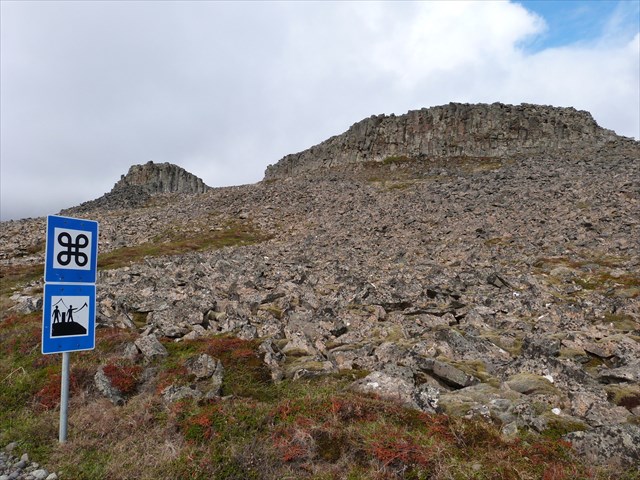Borgarvirki is believed to be a defensive fortification dating from the early years of Iceland's history after the Settlement (c. 870 - 1030 AD), It is formed by an ancient volcanic plug of columnar basalt. The natural rock formation with the addition of manmade fortifications, made Borgarvirki an ideal location for military forces to make a stand against enemies. According to old local tradition, the fortifications are supposed to have been built by Víga-Barði and are mentioned in the Heiðarvíga saga.

This earthcache is not about the history of the site but the Geology.
What is a volcanic plug?
A volcanic plug is also called a volcanic neck or lava neck. the term "neck" is given to the denuded stump of an extinct volcano. When a volcano stops erupting and becomes extinct, remaining magma and other volcanic material may harden in the volcano's pipe, the passageway between the magma chamber and the vent. This material tends to be more resistant to erosion than the enclosing volcanic landform. If a plug is preserved, erosion may remove the surrounding rock while the erosion-resistant plug remains, producing a distinctive upstanding landform (see Photo below).

Photo source: vulkanen.nl
Many volcanic necks stand on lines of fault. In other cases there are groups of necks lying in a straight or sinuous line, which may indicate the position of a fracture or at least of a line of least resistance.
The size of necks varies considerably; the smallest may be only 20 or 30 yds. in diameter, the largest are several miles. In this respect they resemble active craters, but no necks have been met with on the earth's surface with dimensions approaching those of the so-called "craters" of the moon. Small necks are usually simple, i.e. they contain only one or two kinds of igneous rock (ashes and dikes) and have been produced, by a single eruption. Not infrequently they contain no volcanic rock but are filled with pieces of slate, sandstone or whatever strata the pipe traverses. Such necks must have been produced by a single eruption with an outburst of steam, not followed by lava; the disrupted fragments of the surrounding rocks and the materials tumbling down from the crater's walls ultimately filled up the cavity.
Large necks, are often of complex structure, contain many kinds of rock and seem to have been produced by repeated eruptions, each of which more or less completely cleared out the material obstructing the orifice, and introduced a series of fresh accumulations. The beds of ashes which line the interior of an active crater have in nearly all cases a slope or dip towards a central point where the base of the depression is situated, and in volcanic necks which have been filled with ash (tuffs and agglomerates) this funnel-like inward dip is very constant. If there has been only a single eruption the beds of ashes have a very conformable or uniform arrangement, but if activity has been resumed after a period of quiescence a large part of the old material may have been projected and a new series of beds laid down, transgressing unconformably the edges of the earlier ones. By these structures we can sometimes trace a neck within a neck, or of a lateral crater on the margin of a principal one.
To log this Earthcache: you have to send the answers to the following questions via GC profile BEFORE online logging. Please log directly afterwards without waiting for log permission, we will contact you if there will be something sincerely wrong.
Logs not accompanied by email the same day will be deleted per earthcache rules. I don't like doing that. But you need to complete the requirements. The questions are not difficult and are designed so that anyone can fulfill them.
1) Is the material that forms a volcanic neck considered to be solidified magma or lava? Explain.
2) On top of the plug N 65˚ 28.513 W 020˚ 35.788 you find a View point with a magniciefient view over lakes of this area, the villages of Blönduós and Skagaströnd and the mountains.The glacier Eiriksjökull can be seen in good weather conditions. How thick is the wall of the plug at the west side of Borgarvirki?
3) How high are the walls of the vulcanic plug Borgarvirki?
4) Do you think Borgarvirki is a small or large volcanic plug? Explain.
5) A photo of you or the view would be nice but is only optional !!
Sources:
http://en.wikipedia.org/wiki/Borgarvirki
http://www.nat.is/travelguideeng/plofin_borgarvirki.htm
http://en.wikipedia.org/wiki/Volcanic_plug
http://library.thinkquest.org/17457/volcanoes/features.plugs.php